

Grocery retailers will feel the sting of pollinator declines. Bees and other pollinators are essential to the production of one out of every three bites of food we eat.
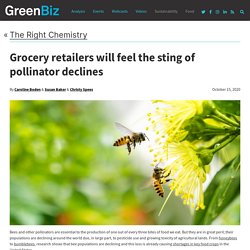
But they are in great peril; their populations are declining around the world due, in large part, to pesticide use and growing toxicity of agricultural lands. From honeybees to bumblebees, research shows that bee populations are declining and this loss is already causing shortages in key food crops in the United States. Without pollinators to help support the production of leading global food crops, grocery retailers are at risk of running short of some of our most important and nutritious foods, including nuts, beans, juices, fruit and vegetables and meat and dairy.
This, in turn, will destabilize and disrupt major supply chains that grocery stores and their customers rely on. Globally, between $235 billion and $577 billion worth of annual food production relies on direct contributions by pollinators. The pollinator crisis needs rapid response from food retailers. More plastic could help create a circular economy – The New Economy.
If companies want to switch to recycled materials, a considerable amount of recycled plastic is needed, which is currently not available on the market Plastic is a valuable material with good versatility.
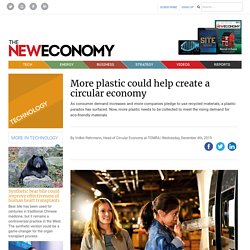
Its value, however, is lost if it’s not treated correctly throughout its life cycle. While consumer awareness grows, governments continue to set regulations to reduce plastic consumption, and companies around the globe are responding with commitments to use recycled materials in their products and packaging. However, this increased demand has created a plastic paradox: there isn’t enough plastic being collected and recycled to meet fresh demand and preserve the planet’s non-renewable resources. A resource revolution is needed to solve this problem. Rethinking the system The amount of plastic waste being produced is growing rapidly, and society’s failure to return plastic into a closed loop is having a negative impact on the environment and on our health.
Achieved circular economy targets could leave 40m tonne residual waste gap. Calculations suggest that 142 million tonnes of residual waste treatment capacity will be needed by 2035 in order to fulfil the currently-set EU targets on municipal waste.
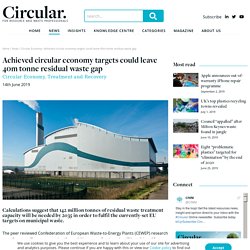
The peer reviewed Confederation of European Waste-to-Energy Plants (CEWEP) research says the gap will occur assuming the ambitious recycling targets will be achieved for commercial and industrial waste. Current waste-to-energy capacity is 90 million tonnes and the capacity for co-incineration is approximately 11 million tonnes. This leaves a gap of around 40 million tonnes, the confederation says. Big trucks, little emissions. One way of increasing sustainability is to reduce carbon fuel emissions within transportation.
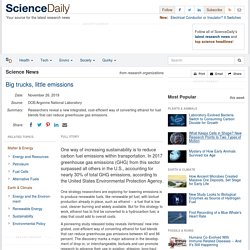
In 2017 greenhouse gas emissions (GHG) from this sector surpassed all others in the U.S., accounting for nearly 30% of total GHG emissions, according to the United States Environmental Protection Agency. New route to carbon-neutral fuels from carbon dioxide. If the idea of flying on battery-powered commercial jets makes you nervous, you can relax a little.
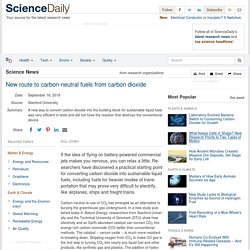
Researchers have discovered a practical starting point for converting carbon dioxide into sustainable liquid fuels, including fuels for heavier modes of transportation that may prove very difficult to electrify, like airplanes, ships and freight trains. Carbon-neutral re-use of CO2 has emerged as an alternative to burying the greenhouse gas underground. In a new study published today in Nature Energy, researchers from Stanford University and the Technical University of Denmark (DTU) show how electricity and an Earth-abundant catalyst can convert CO2 into energy-rich carbon monoxide (CO) better than conventional methods.
'Artificial leaf' successfully produces clean gas. A widely-used gas that is currently produced from fossil fuels can instead be made by an 'artificial leaf' that uses only sunlight, carbon dioxide and water, and which could eventually be used to develop a sustainable liquid fuel alternative to petrol.
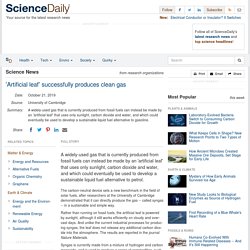
The carbon-neutral device sets a new benchmark in the field of solar fuels, after researchers at the University of Cambridge demonstrated that it can directly produce the gas -- called syngas -- in a sustainable and simple way. Rather than running on fossil fuels, the artificial leaf is powered by sunlight, although it still works efficiently on cloudy and overcast days. And unlike the current industrial processes for producing syngas, the leaf does not release any additional carbon dioxide into the atmosphere. The results are reported in the journal Nature Materials.
Completing The Picture How The Circular Economy Tackles Climate Change V3 26 September. The circular economy can be a holistic approach to addressing climate change. Sustainability 11 01663 v2. England’s 2018 recycling figures show 0.5 per cent decline - Circular Online. The official England ‘waste from households’ recycling rate for 2018 was 44.7 per cent, down 0.5 percentage points from 45.2 per cent in 2017.

Official figures, released yesterday (29 November) by Defra, show that total waste from households in England decreased by 1.8 per cent in 2018 to 22.0 million tonnes, down from 22.4 million tonnes in 2017. This is equivalent to 394 kg per person, down from 403 kg per person in 2017, a decrease of 2.2 per cent. Residual waste treated decreased by 0.9 per cent to 12.2 million tonnes in 2018 from 12.3 million tonnes in 2017.
The amount of total waste recycled has also decreased, down 3.0 per cent from 10.1 million tonnes in 2017 to 9.8 million tonnes in 2018. Targeting “single-use” must go beyond plastic. Shifting away from single-use plastic to different materials in the bottled water market will cause “different environmental problems”, according to new research, which suggests targeting single-use materials for elimination must go beyond plastic.
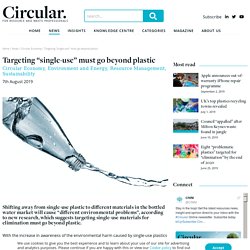
With the increase in awareness of the environmental harm caused by single-use plastics in the natural environment and the number of brands moving away from the material, it has become increasingly easy in the UK to buy water in alternative materials: aluminium cans, glass bottles or cartons. But, according to new research by the Green Alliance, if these containers became even half as common as their plastic counterparts, their annual impact on the planet could be “severe”.